#Thracian settlement
Photo

Thracian settlement
There was once a Thracian settlement here which the Romans made into a fortress called Abritus. During Ottoman domination the town was a major crafts, trade and administrative centre. A monastic school was opened here in the 17th century, followed by a class school in 1812 and a girl’s school in 1848. The library club was founded in 1869. The town was liberated from Ottoman domination in 1878 by Russian troops, under Prince Dondukov-Korsakov.
The town then developed as the centre of a rich agricultural region, with craft and trade but poorly developed industry. Under socialism, Razgrad has quickly become an industrial , administrative and cultural centre with the glass and porcelain works being one of the largest in Europe.
The town has a theatre, district history museum, and various specialised schools.
Hotels: Razgrad, 3 stars, 20 floors, 16 suites, 21 single and 104 double rooms, restaurant, night club, coffee-shop, hairdresser’s, post office, information bureau.
Abritus, accommodating 140, 33 Beli Lom Blvd., tel. 27-06, Republika Restaurant.
Balkantounst bureau, 29 lenin Blvd., Tel,: 26-37
Union of Bulgarian Motorists, 3 Nozharska St.
Tourist attractions:
The ruins of the Roman fortress town of Abntus, discovered in 1953, the town was surrounded by a fortress wall 1215 m high and up to 3 m wide, with four gates. Near the eastern gate there is a 3rd-century building with 23 rooms which was probably the house of a rich landowner sofia guided tours.
The town was captured by the Goths in 251 and in the 6th century it was destroyed by the invading Avars and Slavs.
Tounst attractions:
Ibrahim Pasha Mosque, 1614;
The clock tower, 1864;
Kovanluka Park some 8 km southw’est of the town with ponds, sports grounds, a hotel-restaurant and a national taverna ‘Kolibite’.
During excavations in 1982, under a mound neai the village of Sveshtari, some 6 km northwest of Isperih in the Razgrad district, archaeologists discovered a 3rd century B.C. Thracian tomb. In ancient times this part of Bulgaria was inhabited by the Thracian tribe of the Getae. The tomb has a corridor leading to it and its walls, like the tomb itself, are made of large, well-cut slabs. The entrance is lined with rectangular columns with capitals decorated in red and blue rosetts. Above the columns is a frieze decorated with rosettes and garlands. The tomb proper consists of three chambers united by a semi-cylindrical vault.
The central chamber is decorated with a frieze depicting three female figures in high relief, dressed in long sleeveless robes tied with belts. Their hands are raised as if to support the frieze and they are in the style of the Cariatides in Athens. Another scene is of a goddess offering a wreath to a horseman. This is in black and white and is unique. There are two stone beds in the chamber, probably intended for a Thracian ruler and his wife. The tomb had already been plundered hundreds of years ago — there are traces of extensive damage in the three rooms: broken door slabs, ar-chitectural details, human and animal bones. Investigations continue.
1 note
·
View note
Photo
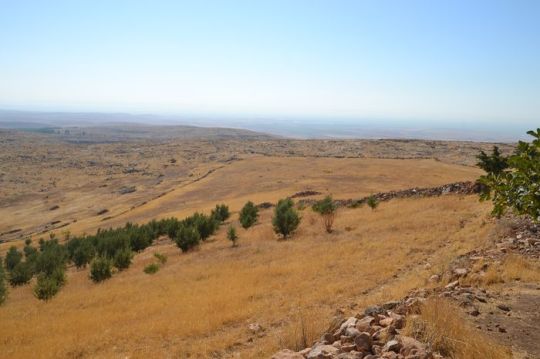
Thracian settlement
There was once a Thracian settlement here which the Romans made into a fortress called Abritus. During Ottoman domination the town was a major crafts, trade and administrative centre. A monastic school was opened here in the 17th century, followed by a class school in 1812 and a girl’s school in 1848. The library club was founded in 1869. The town was liberated from Ottoman domination in 1878 by Russian troops, under Prince Dondukov-Korsakov.
The town then developed as the centre of a rich agricultural region, with craft and trade but poorly developed industry. Under socialism, Razgrad has quickly become an industrial , administrative and cultural centre with the glass and porcelain works being one of the largest in Europe.
The town has a theatre, district history museum, and various specialised schools.
Hotels: Razgrad, 3 stars, 20 floors, 16 suites, 21 single and 104 double rooms, restaurant, night club, coffee-shop, hairdresser’s, post office, information bureau.
Abritus, accommodating 140, 33 Beli Lom Blvd., tel. 27-06, Republika Restaurant.
Balkantounst bureau, 29 lenin Blvd., Tel,: 26-37
Union of Bulgarian Motorists, 3 Nozharska St.
Tourist attractions:
The ruins of the Roman fortress town of Abntus, discovered in 1953, the town was surrounded by a fortress wall 1215 m high and up to 3 m wide, with four gates. Near the eastern gate there is a 3rd-century building with 23 rooms which was probably the house of a rich landowner sofia guided tours.
The town was captured by the Goths in 251 and in the 6th century it was destroyed by the invading Avars and Slavs.
Tounst attractions:
Ibrahim Pasha Mosque, 1614;
The clock tower, 1864;
Kovanluka Park some 8 km southw’est of the town with ponds, sports grounds, a hotel-restaurant and a national taverna ‘Kolibite’.
During excavations in 1982, under a mound neai the village of Sveshtari, some 6 km northwest of Isperih in the Razgrad district, archaeologists discovered a 3rd century B.C. Thracian tomb. In ancient times this part of Bulgaria was inhabited by the Thracian tribe of the Getae. The tomb has a corridor leading to it and its walls, like the tomb itself, are made of large, well-cut slabs. The entrance is lined with rectangular columns with capitals decorated in red and blue rosetts. Above the columns is a frieze decorated with rosettes and garlands. The tomb proper consists of three chambers united by a semi-cylindrical vault.
The central chamber is decorated with a frieze depicting three female figures in high relief, dressed in long sleeveless robes tied with belts. Their hands are raised as if to support the frieze and they are in the style of the Cariatides in Athens. Another scene is of a goddess offering a wreath to a horseman. This is in black and white and is unique. There are two stone beds in the chamber, probably intended for a Thracian ruler and his wife. The tomb had already been plundered hundreds of years ago — there are traces of extensive damage in the three rooms: broken door slabs, ar-chitectural details, human and animal bones. Investigations continue.
0 notes
Photo

Thracian settlement
There was once a Thracian settlement here which the Romans made into a fortress called Abritus. During Ottoman domination the town was a major crafts, trade and administrative centre. A monastic school was opened here in the 17th century, followed by a class school in 1812 and a girl’s school in 1848. The library club was founded in 1869. The town was liberated from Ottoman domination in 1878 by Russian troops, under Prince Dondukov-Korsakov.
The town then developed as the centre of a rich agricultural region, with craft and trade but poorly developed industry. Under socialism, Razgrad has quickly become an industrial , administrative and cultural centre with the glass and porcelain works being one of the largest in Europe.
The town has a theatre, district history museum, and various specialised schools.
Hotels: Razgrad, 3 stars, 20 floors, 16 suites, 21 single and 104 double rooms, restaurant, night club, coffee-shop, hairdresser’s, post office, information bureau.
Abritus, accommodating 140, 33 Beli Lom Blvd., tel. 27-06, Republika Restaurant.
Balkantounst bureau, 29 lenin Blvd., Tel,: 26-37
Union of Bulgarian Motorists, 3 Nozharska St.
Tourist attractions:
The ruins of the Roman fortress town of Abntus, discovered in 1953, the town was surrounded by a fortress wall 1215 m high and up to 3 m wide, with four gates. Near the eastern gate there is a 3rd-century building with 23 rooms which was probably the house of a rich landowner sofia guided tours.
The town was captured by the Goths in 251 and in the 6th century it was destroyed by the invading Avars and Slavs.
Tounst attractions:
Ibrahim Pasha Mosque, 1614;
The clock tower, 1864;
Kovanluka Park some 8 km southw’est of the town with ponds, sports grounds, a hotel-restaurant and a national taverna ‘Kolibite’.
During excavations in 1982, under a mound neai the village of Sveshtari, some 6 km northwest of Isperih in the Razgrad district, archaeologists discovered a 3rd century B.C. Thracian tomb. In ancient times this part of Bulgaria was inhabited by the Thracian tribe of the Getae. The tomb has a corridor leading to it and its walls, like the tomb itself, are made of large, well-cut slabs. The entrance is lined with rectangular columns with capitals decorated in red and blue rosetts. Above the columns is a frieze decorated with rosettes and garlands. The tomb proper consists of three chambers united by a semi-cylindrical vault.
The central chamber is decorated with a frieze depicting three female figures in high relief, dressed in long sleeveless robes tied with belts. Their hands are raised as if to support the frieze and they are in the style of the Cariatides in Athens. Another scene is of a goddess offering a wreath to a horseman. This is in black and white and is unique. There are two stone beds in the chamber, probably intended for a Thracian ruler and his wife. The tomb had already been plundered hundreds of years ago — there are traces of extensive damage in the three rooms: broken door slabs, ar-chitectural details, human and animal bones. Investigations continue.
0 notes
Photo
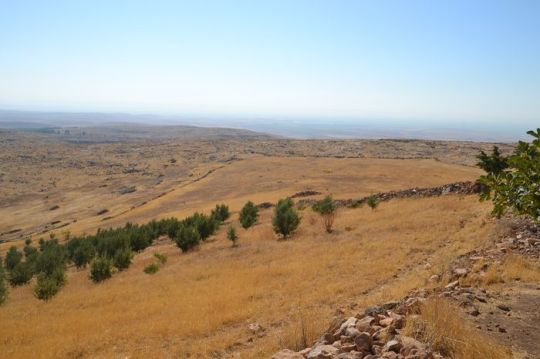
Thracian settlement
There was once a Thracian settlement here which the Romans made into a fortress called Abritus. During Ottoman domination the town was a major crafts, trade and administrative centre. A monastic school was opened here in the 17th century, followed by a class school in 1812 and a girl’s school in 1848. The library club was founded in 1869. The town was liberated from Ottoman domination in 1878 by Russian troops, under Prince Dondukov-Korsakov.
The town then developed as the centre of a rich agricultural region, with craft and trade but poorly developed industry. Under socialism, Razgrad has quickly become an industrial , administrative and cultural centre with the glass and porcelain works being one of the largest in Europe.
The town has a theatre, district history museum, and various specialised schools.
Hotels: Razgrad, 3 stars, 20 floors, 16 suites, 21 single and 104 double rooms, restaurant, night club, coffee-shop, hairdresser’s, post office, information bureau.
Abritus, accommodating 140, 33 Beli Lom Blvd., tel. 27-06, Republika Restaurant.
Balkantounst bureau, 29 lenin Blvd., Tel,: 26-37
Union of Bulgarian Motorists, 3 Nozharska St.
Tourist attractions:
The ruins of the Roman fortress town of Abntus, discovered in 1953, the town was surrounded by a fortress wall 1215 m high and up to 3 m wide, with four gates. Near the eastern gate there is a 3rd-century building with 23 rooms which was probably the house of a rich landowner sofia guided tours.
The town was captured by the Goths in 251 and in the 6th century it was destroyed by the invading Avars and Slavs.
Tounst attractions:
Ibrahim Pasha Mosque, 1614;
The clock tower, 1864;
Kovanluka Park some 8 km southw’est of the town with ponds, sports grounds, a hotel-restaurant and a national taverna ‘Kolibite’.
During excavations in 1982, under a mound neai the village of Sveshtari, some 6 km northwest of Isperih in the Razgrad district, archaeologists discovered a 3rd century B.C. Thracian tomb. In ancient times this part of Bulgaria was inhabited by the Thracian tribe of the Getae. The tomb has a corridor leading to it and its walls, like the tomb itself, are made of large, well-cut slabs. The entrance is lined with rectangular columns with capitals decorated in red and blue rosetts. Above the columns is a frieze decorated with rosettes and garlands. The tomb proper consists of three chambers united by a semi-cylindrical vault.
The central chamber is decorated with a frieze depicting three female figures in high relief, dressed in long sleeveless robes tied with belts. Their hands are raised as if to support the frieze and they are in the style of the Cariatides in Athens. Another scene is of a goddess offering a wreath to a horseman. This is in black and white and is unique. There are two stone beds in the chamber, probably intended for a Thracian ruler and his wife. The tomb had already been plundered hundreds of years ago — there are traces of extensive damage in the three rooms: broken door slabs, ar-chitectural details, human and animal bones. Investigations continue.
0 notes
Photo

Thracian settlement
There was once a Thracian settlement here which the Romans made into a fortress called Abritus. During Ottoman domination the town was a major crafts, trade and administrative centre. A monastic school was opened here in the 17th century, followed by a class school in 1812 and a girl’s school in 1848. The library club was founded in 1869. The town was liberated from Ottoman domination in 1878 by Russian troops, under Prince Dondukov-Korsakov.
The town then developed as the centre of a rich agricultural region, with craft and trade but poorly developed industry. Under socialism, Razgrad has quickly become an industrial , administrative and cultural centre with the glass and porcelain works being one of the largest in Europe.
The town has a theatre, district history museum, and various specialised schools.
Hotels: Razgrad, 3 stars, 20 floors, 16 suites, 21 single and 104 double rooms, restaurant, night club, coffee-shop, hairdresser’s, post office, information bureau.
Abritus, accommodating 140, 33 Beli Lom Blvd., tel. 27-06, Republika Restaurant.
Balkantounst bureau, 29 lenin Blvd., Tel,: 26-37
Union of Bulgarian Motorists, 3 Nozharska St.
Tourist attractions:
The ruins of the Roman fortress town of Abntus, discovered in 1953, the town was surrounded by a fortress wall 1215 m high and up to 3 m wide, with four gates. Near the eastern gate there is a 3rd-century building with 23 rooms which was probably the house of a rich landowner sofia guided tours.
The town was captured by the Goths in 251 and in the 6th century it was destroyed by the invading Avars and Slavs.
Tounst attractions:
Ibrahim Pasha Mosque, 1614;
The clock tower, 1864;
Kovanluka Park some 8 km southw’est of the town with ponds, sports grounds, a hotel-restaurant and a national taverna ‘Kolibite’.
During excavations in 1982, under a mound neai the village of Sveshtari, some 6 km northwest of Isperih in the Razgrad district, archaeologists discovered a 3rd century B.C. Thracian tomb. In ancient times this part of Bulgaria was inhabited by the Thracian tribe of the Getae. The tomb has a corridor leading to it and its walls, like the tomb itself, are made of large, well-cut slabs. The entrance is lined with rectangular columns with capitals decorated in red and blue rosetts. Above the columns is a frieze decorated with rosettes and garlands. The tomb proper consists of three chambers united by a semi-cylindrical vault.
The central chamber is decorated with a frieze depicting three female figures in high relief, dressed in long sleeveless robes tied with belts. Their hands are raised as if to support the frieze and they are in the style of the Cariatides in Athens. Another scene is of a goddess offering a wreath to a horseman. This is in black and white and is unique. There are two stone beds in the chamber, probably intended for a Thracian ruler and his wife. The tomb had already been plundered hundreds of years ago — there are traces of extensive damage in the three rooms: broken door slabs, ar-chitectural details, human and animal bones. Investigations continue.
0 notes
Photo

Thracian settlement
There was once a Thracian settlement here which the Romans made into a fortress called Abritus. During Ottoman domination the town was a major crafts, trade and administrative centre. A monastic school was opened here in the 17th century, followed by a class school in 1812 and a girl’s school in 1848. The library club was founded in 1869. The town was liberated from Ottoman domination in 1878 by Russian troops, under Prince Dondukov-Korsakov.
The town then developed as the centre of a rich agricultural region, with craft and trade but poorly developed industry. Under socialism, Razgrad has quickly become an industrial , administrative and cultural centre with the glass and porcelain works being one of the largest in Europe.
The town has a theatre, district history museum, and various specialised schools.
Hotels: Razgrad, 3 stars, 20 floors, 16 suites, 21 single and 104 double rooms, restaurant, night club, coffee-shop, hairdresser’s, post office, information bureau.
Abritus, accommodating 140, 33 Beli Lom Blvd., tel. 27-06, Republika Restaurant.
Balkantounst bureau, 29 lenin Blvd., Tel,: 26-37
Union of Bulgarian Motorists, 3 Nozharska St.
Tourist attractions:
The ruins of the Roman fortress town of Abntus, discovered in 1953, the town was surrounded by a fortress wall 1215 m high and up to 3 m wide, with four gates. Near the eastern gate there is a 3rd-century building with 23 rooms which was probably the house of a rich landowner sofia guided tours.
The town was captured by the Goths in 251 and in the 6th century it was destroyed by the invading Avars and Slavs.
Tounst attractions:
Ibrahim Pasha Mosque, 1614;
The clock tower, 1864;
Kovanluka Park some 8 km southw’est of the town with ponds, sports grounds, a hotel-restaurant and a national taverna ‘Kolibite’.
During excavations in 1982, under a mound neai the village of Sveshtari, some 6 km northwest of Isperih in the Razgrad district, archaeologists discovered a 3rd century B.C. Thracian tomb. In ancient times this part of Bulgaria was inhabited by the Thracian tribe of the Getae. The tomb has a corridor leading to it and its walls, like the tomb itself, are made of large, well-cut slabs. The entrance is lined with rectangular columns with capitals decorated in red and blue rosetts. Above the columns is a frieze decorated with rosettes and garlands. The tomb proper consists of three chambers united by a semi-cylindrical vault.
The central chamber is decorated with a frieze depicting three female figures in high relief, dressed in long sleeveless robes tied with belts. Their hands are raised as if to support the frieze and they are in the style of the Cariatides in Athens. Another scene is of a goddess offering a wreath to a horseman. This is in black and white and is unique. There are two stone beds in the chamber, probably intended for a Thracian ruler and his wife. The tomb had already been plundered hundreds of years ago — there are traces of extensive damage in the three rooms: broken door slabs, ar-chitectural details, human and animal bones. Investigations continue.
0 notes
Photo

Thracian settlement
There was once a Thracian settlement here which the Romans made into a fortress called Abritus. During Ottoman domination the town was a major crafts, trade and administrative centre. A monastic school was opened here in the 17th century, followed by a class school in 1812 and a girl’s school in 1848. The library club was founded in 1869. The town was liberated from Ottoman domination in 1878 by Russian troops, under Prince Dondukov-Korsakov.
The town then developed as the centre of a rich agricultural region, with craft and trade but poorly developed industry. Under socialism, Razgrad has quickly become an industrial , administrative and cultural centre with the glass and porcelain works being one of the largest in Europe.
The town has a theatre, district history museum, and various specialised schools.
Hotels: Razgrad, 3 stars, 20 floors, 16 suites, 21 single and 104 double rooms, restaurant, night club, coffee-shop, hairdresser’s, post office, information bureau.
Abritus, accommodating 140, 33 Beli Lom Blvd., tel. 27-06, Republika Restaurant.
Balkantounst bureau, 29 lenin Blvd., Tel,: 26-37
Union of Bulgarian Motorists, 3 Nozharska St.
Tourist attractions:
The ruins of the Roman fortress town of Abntus, discovered in 1953, the town was surrounded by a fortress wall 1215 m high and up to 3 m wide, with four gates. Near the eastern gate there is a 3rd-century building with 23 rooms which was probably the house of a rich landowner sofia guided tours.
The town was captured by the Goths in 251 and in the 6th century it was destroyed by the invading Avars and Slavs.
Tounst attractions:
Ibrahim Pasha Mosque, 1614;
The clock tower, 1864;
Kovanluka Park some 8 km southw’est of the town with ponds, sports grounds, a hotel-restaurant and a national taverna ‘Kolibite’.
During excavations in 1982, under a mound neai the village of Sveshtari, some 6 km northwest of Isperih in the Razgrad district, archaeologists discovered a 3rd century B.C. Thracian tomb. In ancient times this part of Bulgaria was inhabited by the Thracian tribe of the Getae. The tomb has a corridor leading to it and its walls, like the tomb itself, are made of large, well-cut slabs. The entrance is lined with rectangular columns with capitals decorated in red and blue rosetts. Above the columns is a frieze decorated with rosettes and garlands. The tomb proper consists of three chambers united by a semi-cylindrical vault.
The central chamber is decorated with a frieze depicting three female figures in high relief, dressed in long sleeveless robes tied with belts. Their hands are raised as if to support the frieze and they are in the style of the Cariatides in Athens. Another scene is of a goddess offering a wreath to a horseman. This is in black and white and is unique. There are two stone beds in the chamber, probably intended for a Thracian ruler and his wife. The tomb had already been plundered hundreds of years ago — there are traces of extensive damage in the three rooms: broken door slabs, ar-chitectural details, human and animal bones. Investigations continue.
0 notes
Photo

Thracian settlement
There was once a Thracian settlement here which the Romans made into a fortress called Abritus. During Ottoman domination the town was a major crafts, trade and administrative centre. A monastic school was opened here in the 17th century, followed by a class school in 1812 and a girl’s school in 1848. The library club was founded in 1869. The town was liberated from Ottoman domination in 1878 by Russian troops, under Prince Dondukov-Korsakov.
The town then developed as the centre of a rich agricultural region, with craft and trade but poorly developed industry. Under socialism, Razgrad has quickly become an industrial , administrative and cultural centre with the glass and porcelain works being one of the largest in Europe.
The town has a theatre, district history museum, and various specialised schools.
Hotels: Razgrad, 3 stars, 20 floors, 16 suites, 21 single and 104 double rooms, restaurant, night club, coffee-shop, hairdresser’s, post office, information bureau.
Abritus, accommodating 140, 33 Beli Lom Blvd., tel. 27-06, Republika Restaurant.
Balkantounst bureau, 29 lenin Blvd., Tel,: 26-37
Union of Bulgarian Motorists, 3 Nozharska St.
Tourist attractions:
The ruins of the Roman fortress town of Abntus, discovered in 1953, the town was surrounded by a fortress wall 1215 m high and up to 3 m wide, with four gates. Near the eastern gate there is a 3rd-century building with 23 rooms which was probably the house of a rich landowner sofia guided tours.
The town was captured by the Goths in 251 and in the 6th century it was destroyed by the invading Avars and Slavs.
Tounst attractions:
Ibrahim Pasha Mosque, 1614;
The clock tower, 1864;
Kovanluka Park some 8 km southw’est of the town with ponds, sports grounds, a hotel-restaurant and a national taverna ‘Kolibite’.
During excavations in 1982, under a mound neai the village of Sveshtari, some 6 km northwest of Isperih in the Razgrad district, archaeologists discovered a 3rd century B.C. Thracian tomb. In ancient times this part of Bulgaria was inhabited by the Thracian tribe of the Getae. The tomb has a corridor leading to it and its walls, like the tomb itself, are made of large, well-cut slabs. The entrance is lined with rectangular columns with capitals decorated in red and blue rosetts. Above the columns is a frieze decorated with rosettes and garlands. The tomb proper consists of three chambers united by a semi-cylindrical vault.
The central chamber is decorated with a frieze depicting three female figures in high relief, dressed in long sleeveless robes tied with belts. Their hands are raised as if to support the frieze and they are in the style of the Cariatides in Athens. Another scene is of a goddess offering a wreath to a horseman. This is in black and white and is unique. There are two stone beds in the chamber, probably intended for a Thracian ruler and his wife. The tomb had already been plundered hundreds of years ago — there are traces of extensive damage in the three rooms: broken door slabs, ar-chitectural details, human and animal bones. Investigations continue.
0 notes
Photo
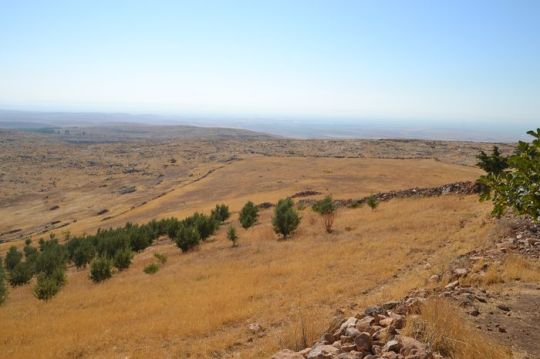
Thracian settlement
There was once a Thracian settlement here which the Romans made into a fortress called Abritus. During Ottoman domination the town was a major crafts, trade and administrative centre. A monastic school was opened here in the 17th century, followed by a class school in 1812 and a girl’s school in 1848. The library club was founded in 1869. The town was liberated from Ottoman domination in 1878 by Russian troops, under Prince Dondukov-Korsakov.
The town then developed as the centre of a rich agricultural region, with craft and trade but poorly developed industry. Under socialism, Razgrad has quickly become an industrial , administrative and cultural centre with the glass and porcelain works being one of the largest in Europe.
The town has a theatre, district history museum, and various specialised schools.
Hotels: Razgrad, 3 stars, 20 floors, 16 suites, 21 single and 104 double rooms, restaurant, night club, coffee-shop, hairdresser’s, post office, information bureau.
Abritus, accommodating 140, 33 Beli Lom Blvd., tel. 27-06, Republika Restaurant.
Balkantounst bureau, 29 lenin Blvd., Tel,: 26-37
Union of Bulgarian Motorists, 3 Nozharska St.
Tourist attractions:
The ruins of the Roman fortress town of Abntus, discovered in 1953, the town was surrounded by a fortress wall 1215 m high and up to 3 m wide, with four gates. Near the eastern gate there is a 3rd-century building with 23 rooms which was probably the house of a rich landowner sofia guided tours.
The town was captured by the Goths in 251 and in the 6th century it was destroyed by the invading Avars and Slavs.
Tounst attractions:
Ibrahim Pasha Mosque, 1614;
The clock tower, 1864;
Kovanluka Park some 8 km southw’est of the town with ponds, sports grounds, a hotel-restaurant and a national taverna ‘Kolibite’.
During excavations in 1982, under a mound neai the village of Sveshtari, some 6 km northwest of Isperih in the Razgrad district, archaeologists discovered a 3rd century B.C. Thracian tomb. In ancient times this part of Bulgaria was inhabited by the Thracian tribe of the Getae. The tomb has a corridor leading to it and its walls, like the tomb itself, are made of large, well-cut slabs. The entrance is lined with rectangular columns with capitals decorated in red and blue rosetts. Above the columns is a frieze decorated with rosettes and garlands. The tomb proper consists of three chambers united by a semi-cylindrical vault.
The central chamber is decorated with a frieze depicting three female figures in high relief, dressed in long sleeveless robes tied with belts. Their hands are raised as if to support the frieze and they are in the style of the Cariatides in Athens. Another scene is of a goddess offering a wreath to a horseman. This is in black and white and is unique. There are two stone beds in the chamber, probably intended for a Thracian ruler and his wife. The tomb had already been plundered hundreds of years ago — there are traces of extensive damage in the three rooms: broken door slabs, ar-chitectural details, human and animal bones. Investigations continue.
0 notes
Photo
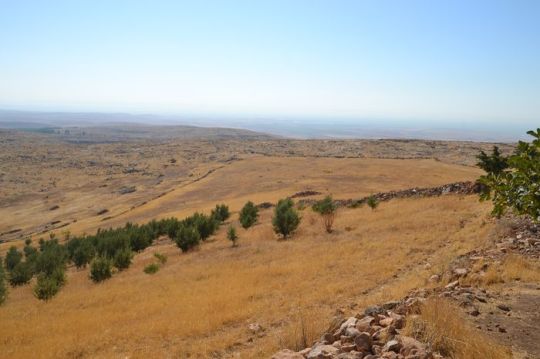
Thracian settlement
There was once a Thracian settlement here which the Romans made into a fortress called Abritus. During Ottoman domination the town was a major crafts, trade and administrative centre. A monastic school was opened here in the 17th century, followed by a class school in 1812 and a girl’s school in 1848. The library club was founded in 1869. The town was liberated from Ottoman domination in 1878 by Russian troops, under Prince Dondukov-Korsakov.
The town then developed as the centre of a rich agricultural region, with craft and trade but poorly developed industry. Under socialism, Razgrad has quickly become an industrial , administrative and cultural centre with the glass and porcelain works being one of the largest in Europe.
The town has a theatre, district history museum, and various specialised schools.
Hotels: Razgrad, 3 stars, 20 floors, 16 suites, 21 single and 104 double rooms, restaurant, night club, coffee-shop, hairdresser’s, post office, information bureau.
Abritus, accommodating 140, 33 Beli Lom Blvd., tel. 27-06, Republika Restaurant.
Balkantounst bureau, 29 lenin Blvd., Tel,: 26-37
Union of Bulgarian Motorists, 3 Nozharska St.
Tourist attractions:
The ruins of the Roman fortress town of Abntus, discovered in 1953, the town was surrounded by a fortress wall 1215 m high and up to 3 m wide, with four gates. Near the eastern gate there is a 3rd-century building with 23 rooms which was probably the house of a rich landowner sofia guided tours.
The town was captured by the Goths in 251 and in the 6th century it was destroyed by the invading Avars and Slavs.
Tounst attractions:
Ibrahim Pasha Mosque, 1614;
The clock tower, 1864;
Kovanluka Park some 8 km southw’est of the town with ponds, sports grounds, a hotel-restaurant and a national taverna ‘Kolibite’.
During excavations in 1982, under a mound neai the village of Sveshtari, some 6 km northwest of Isperih in the Razgrad district, archaeologists discovered a 3rd century B.C. Thracian tomb. In ancient times this part of Bulgaria was inhabited by the Thracian tribe of the Getae. The tomb has a corridor leading to it and its walls, like the tomb itself, are made of large, well-cut slabs. The entrance is lined with rectangular columns with capitals decorated in red and blue rosetts. Above the columns is a frieze decorated with rosettes and garlands. The tomb proper consists of three chambers united by a semi-cylindrical vault.
The central chamber is decorated with a frieze depicting three female figures in high relief, dressed in long sleeveless robes tied with belts. Their hands are raised as if to support the frieze and they are in the style of the Cariatides in Athens. Another scene is of a goddess offering a wreath to a horseman. This is in black and white and is unique. There are two stone beds in the chamber, probably intended for a Thracian ruler and his wife. The tomb had already been plundered hundreds of years ago — there are traces of extensive damage in the three rooms: broken door slabs, ar-chitectural details, human and animal bones. Investigations continue.
0 notes
Photo

Thracian settlement
There was once a Thracian settlement here which the Romans made into a fortress called Abritus. During Ottoman domination the town was a major crafts, trade and administrative centre. A monastic school was opened here in the 17th century, followed by a class school in 1812 and a girl’s school in 1848. The library club was founded in 1869. The town was liberated from Ottoman domination in 1878 by Russian troops, under Prince Dondukov-Korsakov.
The town then developed as the centre of a rich agricultural region, with craft and trade but poorly developed industry. Under socialism, Razgrad has quickly become an industrial , administrative and cultural centre with the glass and porcelain works being one of the largest in Europe.
The town has a theatre, district history museum, and various specialised schools.
Hotels: Razgrad, 3 stars, 20 floors, 16 suites, 21 single and 104 double rooms, restaurant, night club, coffee-shop, hairdresser’s, post office, information bureau.
Abritus, accommodating 140, 33 Beli Lom Blvd., tel. 27-06, Republika Restaurant.
Balkantounst bureau, 29 lenin Blvd., Tel,: 26-37
Union of Bulgarian Motorists, 3 Nozharska St.
Tourist attractions:
The ruins of the Roman fortress town of Abntus, discovered in 1953, the town was surrounded by a fortress wall 1215 m high and up to 3 m wide, with four gates. Near the eastern gate there is a 3rd-century building with 23 rooms which was probably the house of a rich landowner sofia guided tours.
The town was captured by the Goths in 251 and in the 6th century it was destroyed by the invading Avars and Slavs.
Tounst attractions:
Ibrahim Pasha Mosque, 1614;
The clock tower, 1864;
Kovanluka Park some 8 km southw’est of the town with ponds, sports grounds, a hotel-restaurant and a national taverna ‘Kolibite’.
During excavations in 1982, under a mound neai the village of Sveshtari, some 6 km northwest of Isperih in the Razgrad district, archaeologists discovered a 3rd century B.C. Thracian tomb. In ancient times this part of Bulgaria was inhabited by the Thracian tribe of the Getae. The tomb has a corridor leading to it and its walls, like the tomb itself, are made of large, well-cut slabs. The entrance is lined with rectangular columns with capitals decorated in red and blue rosetts. Above the columns is a frieze decorated with rosettes and garlands. The tomb proper consists of three chambers united by a semi-cylindrical vault.
The central chamber is decorated with a frieze depicting three female figures in high relief, dressed in long sleeveless robes tied with belts. Their hands are raised as if to support the frieze and they are in the style of the Cariatides in Athens. Another scene is of a goddess offering a wreath to a horseman. This is in black and white and is unique. There are two stone beds in the chamber, probably intended for a Thracian ruler and his wife. The tomb had already been plundered hundreds of years ago — there are traces of extensive damage in the three rooms: broken door slabs, ar-chitectural details, human and animal bones. Investigations continue.
0 notes
Photo

Thracian settlement
There was once a Thracian settlement here which the Romans made into a fortress called Abritus. During Ottoman domination the town was a major crafts, trade and administrative centre. A monastic school was opened here in the 17th century, followed by a class school in 1812 and a girl’s school in 1848. The library club was founded in 1869. The town was liberated from Ottoman domination in 1878 by Russian troops, under Prince Dondukov-Korsakov.
The town then developed as the centre of a rich agricultural region, with craft and trade but poorly developed industry. Under socialism, Razgrad has quickly become an industrial , administrative and cultural centre with the glass and porcelain works being one of the largest in Europe.
The town has a theatre, district history museum, and various specialised schools.
Hotels: Razgrad, 3 stars, 20 floors, 16 suites, 21 single and 104 double rooms, restaurant, night club, coffee-shop, hairdresser’s, post office, information bureau.
Abritus, accommodating 140, 33 Beli Lom Blvd., tel. 27-06, Republika Restaurant.
Balkantounst bureau, 29 lenin Blvd., Tel,: 26-37
Union of Bulgarian Motorists, 3 Nozharska St.
Tourist attractions:
The ruins of the Roman fortress town of Abntus, discovered in 1953, the town was surrounded by a fortress wall 1215 m high and up to 3 m wide, with four gates. Near the eastern gate there is a 3rd-century building with 23 rooms which was probably the house of a rich landowner sofia guided tours.
The town was captured by the Goths in 251 and in the 6th century it was destroyed by the invading Avars and Slavs.
Tounst attractions:
Ibrahim Pasha Mosque, 1614;
The clock tower, 1864;
Kovanluka Park some 8 km southw’est of the town with ponds, sports grounds, a hotel-restaurant and a national taverna ‘Kolibite’.
During excavations in 1982, under a mound neai the village of Sveshtari, some 6 km northwest of Isperih in the Razgrad district, archaeologists discovered a 3rd century B.C. Thracian tomb. In ancient times this part of Bulgaria was inhabited by the Thracian tribe of the Getae. The tomb has a corridor leading to it and its walls, like the tomb itself, are made of large, well-cut slabs. The entrance is lined with rectangular columns with capitals decorated in red and blue rosetts. Above the columns is a frieze decorated with rosettes and garlands. The tomb proper consists of three chambers united by a semi-cylindrical vault.
The central chamber is decorated with a frieze depicting three female figures in high relief, dressed in long sleeveless robes tied with belts. Their hands are raised as if to support the frieze and they are in the style of the Cariatides in Athens. Another scene is of a goddess offering a wreath to a horseman. This is in black and white and is unique. There are two stone beds in the chamber, probably intended for a Thracian ruler and his wife. The tomb had already been plundered hundreds of years ago — there are traces of extensive damage in the three rooms: broken door slabs, ar-chitectural details, human and animal bones. Investigations continue.
0 notes
Photo

Thracian settlement
There was once a Thracian settlement here which the Romans made into a fortress called Abritus. During Ottoman domination the town was a major crafts, trade and administrative centre. A monastic school was opened here in the 17th century, followed by a class school in 1812 and a girl’s school in 1848. The library club was founded in 1869. The town was liberated from Ottoman domination in 1878 by Russian troops, under Prince Dondukov-Korsakov.
The town then developed as the centre of a rich agricultural region, with craft and trade but poorly developed industry. Under socialism, Razgrad has quickly become an industrial , administrative and cultural centre with the glass and porcelain works being one of the largest in Europe.
The town has a theatre, district history museum, and various specialised schools.
Hotels: Razgrad, 3 stars, 20 floors, 16 suites, 21 single and 104 double rooms, restaurant, night club, coffee-shop, hairdresser’s, post office, information bureau.
Abritus, accommodating 140, 33 Beli Lom Blvd., tel. 27-06, Republika Restaurant.
Balkantounst bureau, 29 lenin Blvd., Tel,: 26-37
Union of Bulgarian Motorists, 3 Nozharska St.
Tourist attractions:
The ruins of the Roman fortress town of Abntus, discovered in 1953, the town was surrounded by a fortress wall 1215 m high and up to 3 m wide, with four gates. Near the eastern gate there is a 3rd-century building with 23 rooms which was probably the house of a rich landowner sofia guided tours.
The town was captured by the Goths in 251 and in the 6th century it was destroyed by the invading Avars and Slavs.
Tounst attractions:
Ibrahim Pasha Mosque, 1614;
The clock tower, 1864;
Kovanluka Park some 8 km southw’est of the town with ponds, sports grounds, a hotel-restaurant and a national taverna ‘Kolibite’.
During excavations in 1982, under a mound neai the village of Sveshtari, some 6 km northwest of Isperih in the Razgrad district, archaeologists discovered a 3rd century B.C. Thracian tomb. In ancient times this part of Bulgaria was inhabited by the Thracian tribe of the Getae. The tomb has a corridor leading to it and its walls, like the tomb itself, are made of large, well-cut slabs. The entrance is lined with rectangular columns with capitals decorated in red and blue rosetts. Above the columns is a frieze decorated with rosettes and garlands. The tomb proper consists of three chambers united by a semi-cylindrical vault.
The central chamber is decorated with a frieze depicting three female figures in high relief, dressed in long sleeveless robes tied with belts. Their hands are raised as if to support the frieze and they are in the style of the Cariatides in Athens. Another scene is of a goddess offering a wreath to a horseman. This is in black and white and is unique. There are two stone beds in the chamber, probably intended for a Thracian ruler and his wife. The tomb had already been plundered hundreds of years ago — there are traces of extensive damage in the three rooms: broken door slabs, ar-chitectural details, human and animal bones. Investigations continue.
0 notes
Text

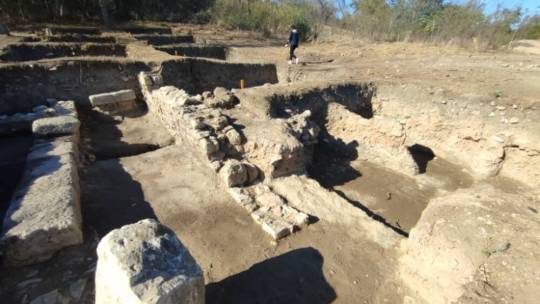
Archaeologists Discovered Roman Floor Mosaics in Bulgaria
Archaeologists discovered floor mosaics with early Christian designs and nearly 800 artifacts in the archaeological reserve of Marcianopolis in Devnya, in the northeastern part of Bulgaria.
The Roman town of Marcianopolis (present-day Devnya) in northeastern Bulgaria appears to have originated as a Thracian settlement. It was later inhabited by Hellenized settlers from Asia Minor and named Parthenopolis.

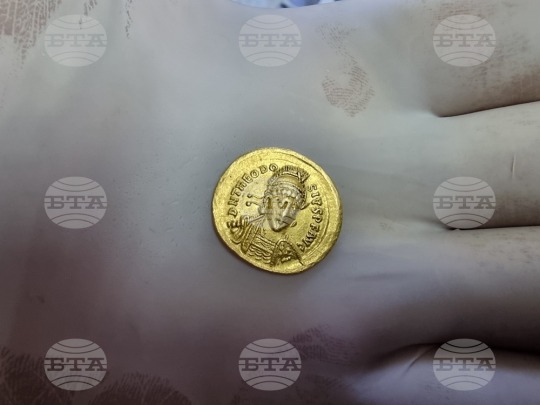
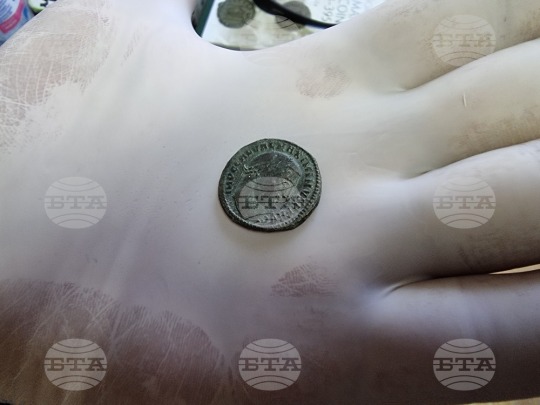
Roman Marcianopolis was established around 106 CE, following Trajan’s campaigns in Dacia to the north. The settlement was named after his sister, Ulpia Marciana. At the crossroads between Odessos (modern Varna), Durostorum, and Nicopolis ad Istrum, as well as the location of plentiful springs, Marcianopolis became a strategically important settlement.
Diocletian’s administrative reforms in the late third century CE divided Moesia Inferior into Moesia Secunda and Scythia Minor, with Marcianopolis serving as the former’s administrative capital. Marcianopolis experienced its most prosperous period during the middle of the fourth century CE. From 367 CE to 369 CE, the eastern emperor Valens used Marcianopolis as his winter quarters during campaigns against Visigoth incursions in the region. During this time, it served as the Eastern Empire’s temporary capital.

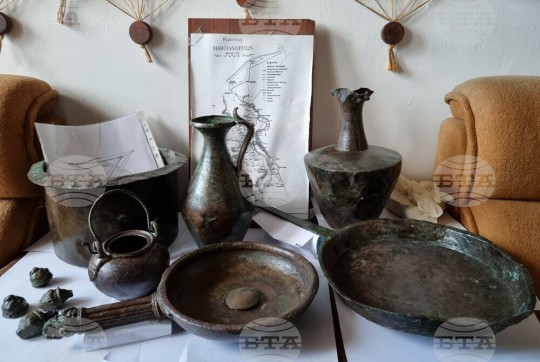

Floor mosaics with early Christian designs were found in the remains of a building. Archaeologists are not yet sure whether it was a public building or it belonged to a rich Roman citizen.
The tentative dating of the mosaics is in the first half of the 4th century AD.
The finds from the current archaeological season in Devnya contain another thousand bronze coins, several clay lamps and two clay vessels, which are awaiting scientific processing and restoration.
During the past archeological season, researchers restored bronze vessels discovered in the 1990s in a brick-walled tomb dating to the late 2nd – early 3rd century.
The vessels had a ritual use and were related to the personality of the person buried, Mosaic Museum director Ivan Sutev said in a statement to BTA.


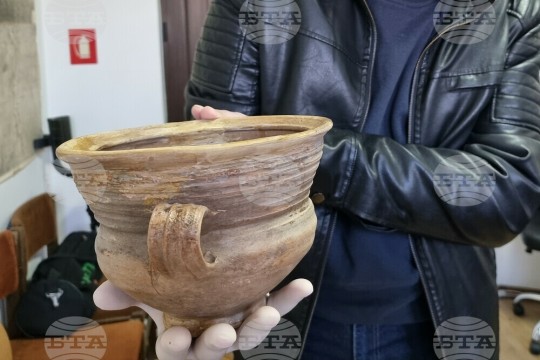

They are richly decorated and the workmanship is exquisite, he added. The find includes a vessel for pouring liquids as offering to a deity, and a wine jug with a trefoil mouth (oenochoe). A simple kitchen pan was also found along with these. All this leads archaeologists to suggest that a Roman citizen of Marcianopolis may have been laid to rest in the tomb, but that he may have had more specific functions: a soldier, a cook, or even a priest, Sutev said.
Pottery that was discovered in the basilica’s environs during excavations in 2023 has since been restored. Among these are a mortarium vessel for liquids and an exquisite crater-shaped pot for liquids. These were located in the structure with the mosaic floors. Coins from the time of Emperor Theodosius II were also found scattered on the floor.
In 447, Attila’s Huns captured and destroyed Marcionopolis after conquering the entire Balkan Peninsula but failing to capture Constantinople. That is determined by 20 gold coins scattered on the floor of the building being studied. On one side of the coins is an image of Theodosius II, while on the other is the patron goddess of Constantinople. Among the coins discovered during the Marcianopolis excavations were those from the city’s founding in the second century. The latter are dated to the sixth century, around the time of Emperor Justinian.
By Oguz Buyukyildirim.
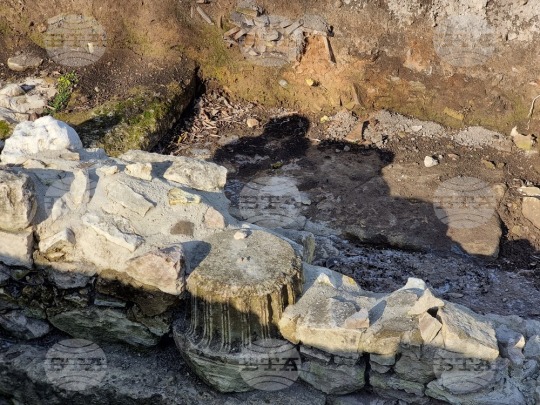
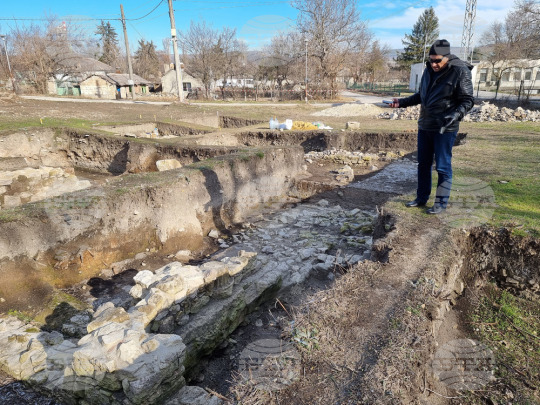
#Archaeologists Discovered Roman Floor Mosaics in Bulgaria#The Roman town of Marcianopolis#gold#gold coins#roman gold coins#ancient artifacts#archeology#archeolgst#history#history news#ancient history#ancient culture#ancient civilizations#roman history#roman empire#roman art#Emperor Theodosius II
44 notes
·
View notes
Note
Is that a Karditsa accent? I do understand everything she is saying. It kind of sounded like she had a eastern/slavic twang to her accent, to my ears at least. I did not know that regional greek accents could be that distinct lol I am learning greek but have mostly interacted with the "standard" atheian-esque accent so far :)
Yes, it looks like that's the Karditsa accent. The old accents in Thessalia (region) are similar to that. But wait till you listen to Pontiac, Thracian, Cypriot and Cretan Greek 😂
I'm not entirely sure it sounds like this because of interaction with Slavs. I think Thracian Greek has that Slavic element to it. And it goes without saying that the development of an accent can be a result of isolation, too, and not a result of exterior influence.
Buuut the Thessalian accent could still have been affected by Slavic languages, just in a different way. The Slavs had strong presence there since the 7th century and most of them later got Hellenized.
It's worth noting half of Greece has/had large interaction with Slavic peoples, and many north settlements were Slavic in culture. (If one looks the composition of their area before the Lausanne Treaty and the Smyrna destruction they might be surprised)
Truth is, dialects and idioms have largely fallen out of use now that we are all exposed to the same media (which use the standard Greek) and standardized education. Of course the most distinct idioms are still known by the people in the regions, and there are many local channels who may keep the idioms, but the idioms/dialects are rarely used. Some old words and phrasing has stuck in most cases. Other than that, it looks like Greeks are assimilating to a larger linguistic norm. (That being said, I am a huge fan of preserving heritage and culture and I don't want old dialects and idioms to be lost)
If you guys still know and speak the old dialects, please comment and tell us your experience!
16 notes
·
View notes
Note
Omg people need to leave Hagia Sophia and Constantinople alone from all this political debate. Constantinople was first a Greek city thousands of years before it fell into Ottoman hands!
According to Pliny the Elder the first name of Byzantium was Lygos. This may have been the name of a Thracian settlement situated on the site of the later city.
Then Byzantium, then new Rome and the rest is known. Yet even during ottoman empire, Constantinople was named Kostantiniyye but they don't mention it 👀
.
3 notes
·
View notes